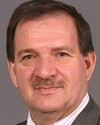Thank you. I'm honoured to be invited to testify before this committee.
My name is Jack Weinberg. I'm a senior policy adviser to the International POPs Elimination Network, which is a network of non-governmental organizations in 70 countries. It started around the negotiation of the Stockholm Convention and now works more generally on chemical policy.
I got a call from colleagues on Monday—I live in Chicago—to come in on this, so I will try to shed as much light as I can. Although I've not been following your debates, I did prepare some notes.
Without talking about the study per se, although we can go into what I can share on it, my heart sank when I heard Dr. Schwarcz's comments, since I thought we had gone beyond some of those debates some time back. Let me give some examples, and then maybe I can go into more detail on how they might relate.
First of all, while the precautionary principle is embraced in most of the world, there is nowhere that it's embraced as a no-risk policy. The precautionary principle balances three important components. The first is that there is substantial reason to believe there's a cause-and-effect relationship—not necessarily definite proof, because that's almost impossible, but some substantial reason. The second is that the potential for harm is large-scale and irreversible. The third is a socio-economic consideration: what are the relative social implications and cost implications, and are alternatives available, and so forth.
A policy that's based on the precautionary principle, which CEPA has been and which it needs to continue to be, is a policy that balances in a proper way those three considerations and doesn't get stampeded by efforts to create scientific doubt and the whole manufacture of scientific uncertainty, which was begun with the public relations organizations supporting the tobacco industry, where the term “sound science” was first initiated.
The whole manufacture of doubt has become a large-scale industry. We've seen it with climate change. The cause and effect relationships in toxicology are much more complicated and the issues are much more individual, and therefore the manufacture of doubt is a much more lucrative industry and much easier to pursue.
I want to give an example of the kinds of things we heard that sound good on the surface but then fall apart. We talked about PBDEs. The study said there were 0.5 micrograms per litre in the blood, and since there are five litres of blood in a human body, we're talking about 2.5 micrograms in the human body. Well, that would make sense if blood were the main place where these pollutants are stored. But we know these pollutants are lipophilic; they're primarily stored in the fat. They only appear in the blood because there is some fat in the blood. So the kind of “sound science” that takes the only thing we know, which is what was found in somebody's blood, and therefore generalizes to a full-body burden of 2.5 micrograms in the body, is not sound science at all. It is public relations.
Let me give another example. We were told—and it's correct—that there are many forms of dioxin. The four-chlorine—the tetras, with a chlorine on the four corners—are the most toxic. That's well known. It's also well known that the octas, which are the common dioxin form—not the bichlorine, but the octas—are the really not highly.... But we've all known that for many years, and no place in the world that I know of regulates dioxin by individual congeners.
Scientists and policy people have come up with a notion of “toxic equivalency factors”, taking the tetras as one and then assigning all the other congeners a fraction; then, whenever you analyze for dioxin you come up with a toxic equivalency, the TEQ. All regulation on dioxin is based on TEQ, because there's recognition.
So again that was throwing smoke. That was not based on any real debate that's going on.
Also, as to this stuff about the apples and oranges, CEPA, I presume, like other chemical policy legislation, addresses anthropogenic toxic substances. It doesn't represent all chemicals; we're all made of chemicals. It's anthropogenic.
By anthropogenic, it's either things that are synthetic, things that are man-made, or since a lot of things that are man-made also exist in nature and because there are other ways of getting toxic materials into nature other than their manufacture, there are also toxic substances that are mobilized in nature, in the environment, by human activity in unnatural quantities. So it's anthropogenic toxic substances that we are talking about, not all chemicals.
The reason this is an important matter is that we started out, as you recall, when there was a hole in the ozone layer, and there was the question of the science, tying ozone-depleting substances to the stratospheric ozone depletion. That was debated for a while. It was opposed and the science was debated, but it was finally resolved.
Then we went through a much more bitter debate about greenhouse gases in the atmosphere. Again, the actual basic mechanism is extremely simple, so the manufacture of doubt was on all the actual climate science and the mechanisms and sinks, and all that sort of thing. So we lost a good decade, and maybe we'll lose more, in dealing with an extremely difficult problem that, once we recognize it, we'll find that the things we have in place are not sufficient to deal with it. It's a very serious problem to the world.
But the question before us today, anthropogenic toxic substances, is much more complicated. The stratosphere is a rather simple mechanism. For the atmosphere, the mechanism was simple but the climate models were difficult. Now we're talking about the biosphere--that is, humans and all living things evolved in a particular chemical environment, and everything about us is chemical.
Biochemistry is the miracle under which the fetus develops. We develop into full human beings. All our bodily functions are managed by a biochemical process.
We are now introducing a large number of anthropogenic toxic substances into this biosphere, and some of the impacts are known, and some are less known, but we cannot accept any longer....
We thought this was resolved with science that originated in the Great Lakes of U.S. and Canada in the 1980s and early 1990s. LD 500, where you see how much it takes to kill a fish, is not the be-all and end-all of toxicology. That's one aspect. That's for acute poison; that's what kills.
What we learn is in regard to what has been called endocrine disruption, but I think sometimes that gets confusing. So even though this is not the normal word, I prefer to call it signal disruption, because that's a more general term.
Most biological processes are managed through receptors on cells. Chemicals, then, are attached to that receptor, and they trigger some kind of activity. That's how development occurs. That's how bodies function. So that's receptors. It's very complicated. So you have a chemical information exchange system that goes on in the human body. It's also through smelling. Some animals exchange information that's necessary through hormones, but you have very complicated chemical information exchange systems.
Signal disruption comes when chemicals that are synthetic or anthropogenic, either in their existence or in their quantities in the environment, which are different from the conditions under which these organisms evolved, are suddenly in the environment in quantities that are putting noise into a very complicated signaling system. That noise can take the form of a chemical that attaches to a receptor and triggers an action that's not supposed to be triggered. It can take the form of a chemical that attaches to a receptor and prevents it from reacting when it should react. Or in other ways it can interfere with the chemical before it reaches the reactor.
So a large number of health effects that began to be understood only in the 1980s and early 1990s, largely initiated by research in the Great Lakes, are mediated by these signal disruption mechanisms. Endocrine disruption is the mostly commonly discussed, but it's broad, and the dose equals the poison.
While it might have been adequate for the 16th century, science no longer addresses this. I think most scientists believe that for dioxin in the vicinity of zero, the dose response curve is linear to zero. I think that's been disproved, although there are many efforts to fudge it.
I think the dioxin dose response curve in the vicinity of zero.... But in large quantities of dioxin, as we saw, the prime minister to be of the Ukraine was poisoned with a large quantity of pure dioxin, and he didn't die. A lot of the signal-disrupting chemicals have very strange dose response curves. Some scientists have even been finding U-shaped dose response curves. Where it's close to zero, it's going up quite rapidly. Then not only does it taper off, but in larger doses it starts going down. This is because biological systems will respond to small doses as a signal of some kind, but when the dose gets large, that whole system shuts down, so as not to overreact the system.
We're not dealing with LD500s, and we're not dealing with how much will kill you and not much under that. We're dealing with a large number of effects that affect intelligence, learning ability, behaviour disorders, and a developing fetus. We're dealing with reproductive effects, such as the one that was mentioned from Servaso, and many other reproductive effects. We're dealing with immunological system dysfunctions that we still don't fully understand. Very likely, we're dealing with the prevalence of prostate cancer and other prostate problems in males of my age, caused by events that occurred when I was a fetus. It took all that time to develop.
These things were all discussed when I was following Great Lakes environmental issues ten years ago, and more. These are the problems that we have to address.
More was said in that presentation and in question and answer, but I'm sorry to say I'm not a trained toxicologist. I'm just a well-read layperson. I do admit to being an advocate.
I think those are very important questions, and I want to say a little, if I can conclude, about this committee.



